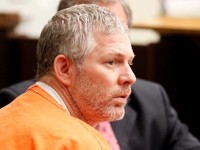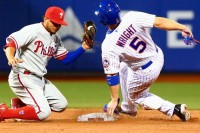Lenny Dykstra

By now, you’ve heard that Lenny Dykstra used private eyes to gather information on umpires for his benefit:
Do I think Dykstra is capable of this? Absolutely. However, he’s capable of it. I still don’t believe him.
Now, we need to pinpoint the veracity of his claim, we need to figure out when it supposedly happened. He wasn’t definitive when, but he knew the net result was the walks. The key to his statement was the year after he did this, he lead the league in walks. Looking at this, his statement proves out.
In 1992, he only had 40 walks. The next year his walks soared astronomically. He went from those 40 walks to 129 walks. It’s also true there was money at stake because Dykstra was arbitration eligible. This is where the story falls apart.
In 1992, Dykstra made $2,316,667. The typical percentage paid to an agent is 5%. That reduces his income to $2,200,834. Union dues were $3,660. It’s negligible, but it reduces the income to $2,197,173. Now, there’s the tax issue. The tax rate in 1992 was 31%. There are deductions and the like which would reduce the effective tax rate. However, he also has state and city taxes to pay. Pennsylvania had a flat rate of 2.95%. To be conservative, let’s assume Dykstra paid 25% in taxes.
Dykstra’s disposable income would then be $1,647,880. This doesn’t even include living expenses. Are we to believe Dykstra spent roughly one-third of his disposable income on blackmailing umpires. I can’t. There’s a bigger reason beyond the financial feasibility.
It doesn’t make sense. Let’s say Dykstra did as he said. Wouldn’t the catcher use the same information to get strike calls for his pitcher. Was there a spike in catcher walk rates I don’t know about? Of course not. Let’s call it for what it is. He had a career year.
Besides that, his walk rate declined. It was 0.80 in 1993 and 1994. The next year? It was 0.65. Did the umpires start ignoring him? No. He had two good years. Why? We it just so happens he started using steroids. His slugging percentage went from .402 to .482. He went from 6 to 19 homers. He went from 18 to 44 doubles. Pitchers will be more careful and more likely to walk you.
However, that’s not the main reason I don’t believe him. The main reason I don’t believe him is he’s a fraud. Literally. He lead everyone to believe he was a money genius. He was just cheating the system just like he did with the steroids. He’s lied and concealed. It’s the behavior that makes you think he could’ve spied on umpires. Ultimately, however, it seems more like the typical braggadocio he’s had his entire life.
It sure made a good story, but that’s all it is. A story.

There are two choices for 4. The first is Ron Swoboda, who was a key contributor to the 1969 Mets World Series victory:
However, my choice for Magic Man Number 4 will be Lenny Dykstra:
I chose Dykstra mostly because I got to see him play. I chose him because he was amazing in the 1986 postseason.
In the NLCS, he hit .304/.360/.565. He hit a walk off two run homerun in Game 3 of the NLCS to give the Mets a 6-5 win. He got the Game 6 ninth inning rally started with a leadoff triple. Everyone who watched this NLCS discuss the importance of winning in six with NLCS MVP Mike Scott scheduled to pitch Game 7.
In the World Series, Dykstra hit .296/.345/.519. Strangely enough, Dykstra was so big in big games that this was his worst ever postseason series. Dykstra lead off Game 3 in Boston with a homerun. This was important as the Mets came to Boston after losing the first two at Shea.
When Dykstra did all of this, he was only 23 years old. It shows that it’s not an issue of experience come October. Rather, it’s an issue of who has ice water running through their veins. This is important to keep in mind because the Mets run largely rests with their young pitching.
The young pitching has met every challenge thus far. As Dykstra shows us, they will meet the challenges they face en route to the World Series.

I’m not the first, and I’m not going to be the last to compare David Wright and Don Mattingly. My goal today is to hopefully be a little more nuanced than a side by side comparison. Rather, I want to see exactly how back problems deteriorated Mattingly’s abilities.
Normally, I would use Lenny Dykstra as a comparable because he also has spinal stenosis. However, I don’t know if I can trust any of his stats with his steroids usage. We do know like Wright, Mattingly suffered from a low back injury. The nature of the two injuries are different, but they are both chronic problems.
It appears the problems first surfaced in 1987. In that year, Mattingly went from a 7.2 WAR to a 5.1 WAR player. In essence, he went from a superstar to an All Star player. He would then quickly deteriorate into just a “good” player. Mattingly’s back worsened in 1990, and with that he became a -0.3 player, which translates to a bad player. For the rest of his career, Mattingly would be nothing more than a solid starter. He retired at the early age of 34.
Wright has had a terrific career, arguably better than Mattingly. In 2007 and 2008, Wright was a superstar player, as per WAR. In 2009, the Mets moved to Citi Field and Wright was nothing more than a solid starter. In 2010, Wright suffered a broken back. Unlike Mattingly, Wright would rebound from his back injury to put up superstar numbers again in 2012 and 2013.
Last year, Wright regressed again. However, last year it was a shoulder injury and not a back injury. This year it was discovered that Wright has spinal stenosis. We don’t know if it’s related to the 2010 injury.
What I do know is that Wright and Mattingly are two different players. We have seen that Wright once overcame a back injury, a different back injury, to return to superstar form. Mattingly never did. So yes, both are popular New York corner infielders. Both have back injuries.
However, they are two different players with two different back injuries. We shouldn’t be comparing them to determine how the rest of Wright’s career is going to proceed. Wright is a different player and person.
I’m nervous about Wright, but after 2012 and 2013, I won’t bet against him.

Over the course of their history, the Mets have made some really bad trades that were indefensible at the time they were made. While this isn’t a complete list, here are some of my “favorites”:
- The Midnight Massacre,
- Lenny Dykstra, Roger McDowell, and Tom Edens for Juan Samuel, and
- Scott Kazmir and Jose Diaz for Victor Zambrano and Bartolome Fortunato.
Again, this is not a comprehensive list. Also, these were traded roundly criticized at the time, not ones that eventually turned out badly.
It’s funny. Late last night into early this morning many people were joking about how people who went to bed early last night would react when they discovered the trade unraveled. It immediately made me think of the aforementioned Midnight Massacre.
I thought about how people felt when they read the newspaper the next morning. We all know everyone hated the trade and vilified the Mets to the point that Shea was once known as Grant’s Tomb. The trade worked out as bad as everyone thought it would. I began to wonder if the Carlos Gomez trade would’ve joined the list of worst Mets’ trades ever.
As I noted last night, Carlos Gomez was having a down year. Admittedly, I was unaware there were possible injury concerns. Reportedly, the Mets nixed the deal over Gomez’s hip issues. Gomez was reported that have said he’s stopped running due to his hip issues.
The arguments started over whether there was a hip issue or not. Many pointed out that he was playing everyday. Despite these opinions, the Mets believed Gomez had a degenerative hip issue. For what it’s worth, Gomez had trouble staying healthy this year. Regardless, the Mets seemed disappointed because they really wanted Gomez.
Mets fans wanted him too. Would they have been as enthusiastic if Gomez landed on the DL with a hip issue? Would they have booed him if he was ineffective due to his degenerative hip? Would they be screaming same old Mets? Yes to all the above, and part of the reason is they would’ve given up Zack Wheeler to get him.
I’ve detailed before how the Mets could afford to part with Wheeler for a non-rental player. However, it is dumb to trade him for a player that’s an injury risk even if he never gets injured and/or he would be a huge upgrade.
As I’ve noted, Wheeler has been a league average pitcher with the Mets with a lot of potential. However, he seemed to turn a corner in the second half last year. He went 6-3 with a 3.04 ERA. He averaged 9.6 strikeouts per nine innings. He dropped his WHIP from 1.357 to 1.286.
He was making real progress in his first full professional season. He’s under team control until 2020. This is a valuable asset and trade chip. You don’t give that up for a hope and a prayer especially when the Mets don’t have the best history dealing with injuries.
While Sandy Alderson and the Mets may invite criticism from time to time, this should not be one of those instances. Initially, he made a good trade to improve the team. He made a better decision walking away from the deal.
